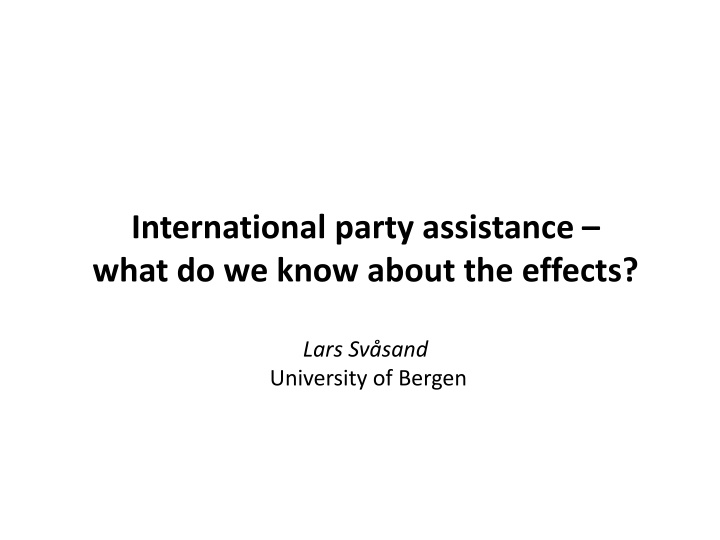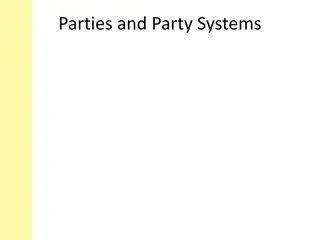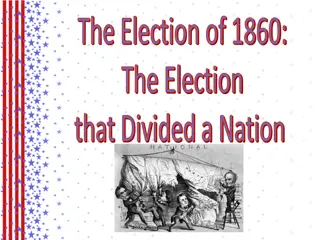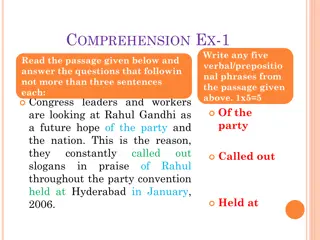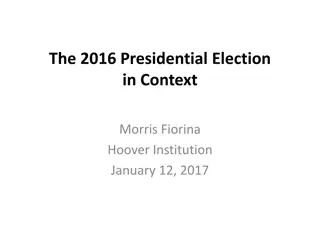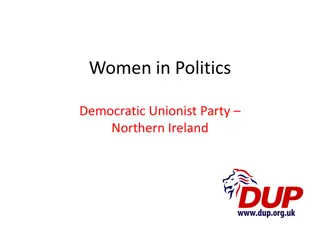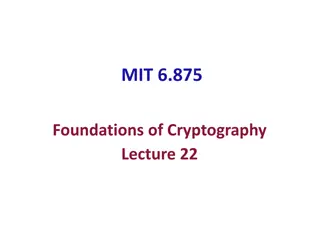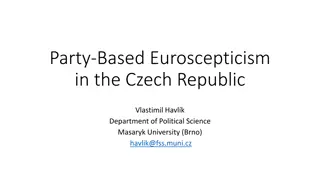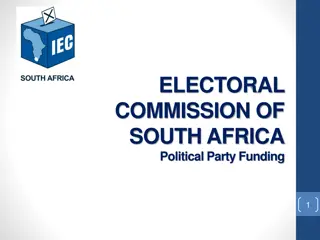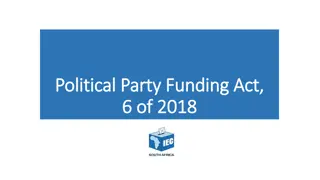The Impact of International Party Assistance: Objectives, Models, and Outcomes
Exploring the effects of International Party Assistance (IPA), this study delves into its objectives, organizational models, and financial scales. The key goals include promoting democratic consolidation, stable party systems, and viable political parties. Various modes of intervention, both direct and indirect, are highlighted alongside the involvement of party-affiliated organizations and donors. The discussion sheds light on the complexities and challenges faced in enhancing democratic processes through international assistance.
Download Presentation

Please find below an Image/Link to download the presentation.
The content on the website is provided AS IS for your information and personal use only. It may not be sold, licensed, or shared on other websites without obtaining consent from the author.If you encounter any issues during the download, it is possible that the publisher has removed the file from their server.
You are allowed to download the files provided on this website for personal or commercial use, subject to the condition that they are used lawfully. All files are the property of their respective owners.
The content on the website is provided AS IS for your information and personal use only. It may not be sold, licensed, or shared on other websites without obtaining consent from the author.
E N D
Presentation Transcript
International party assistance what do we know about the effects? Lars Sv sand University of Bergen
International party assistance what and why? The organizational effort to support democratic political parties, to promote a peaceful interaction between parties, and to strengthen the democratic political and legal environment for political parties (Burnell & Gerritts, 2010) Motivations: Parties as necessary institutions in democracies Parties and civil society Problems: International actors involved in domestic processes Contextual challenges Does IPA work?
Dimensions of International Party Assistance (IPA) 1. Objectives of IPA, 2. Organizational model 3. Financial scale of intervention 4. Modes of intervention 5. Timing of intervention 6. Geographic focus
1. Objectives of IPA Overall goal: Contribute to democratic consolidation Sub-goals: a) Contribute to a stable party system b) Contribute to viable political parties Operational targets: 1. Securing a particular political outcome 2. Support for particular single parties 3. Supporting all or multiple parties 4. Improving the party system 5. Supporting groups of political actors
Party affiliated organizations (Germany, United States, Sweden,Norway 2010-) 2. Donors and organizational models Party affiliated and inter-party institution (United Kingdom, Denmark, Norway (2002-2010) Inter-party institution (The Netherlands) Multilateral IIDEA Int. Institute for Democracy and Electoral Assistance UNDP: United Nations Development Program
3. Financial scale of intervention Donor Year(s) million EUR/year Sweden: PAO Denmark: DIPD Norway: Pol. parties UK: WFD the Netherlands: NIMD 2011-2014 2011-2013 2013 2013-2014 2015 8.8 3.4 0.8 2.6 12.4
4. Modes of intervention Direct vs indirect IPA Examples of direct IPA: Cash support for specified projects (strengthening party HQ) Capacity building (training election monitors for party candidates) Exchange visits Creating arenas for inter-party dialogue Examples of indirect IPA: Strengthening parliament as an institution Supporting the electoral management body Increasing media plurality
5. Timing of intervention Pre-transition Transition phase Democratic consolidation
6. Geographic focus New democracies 2014 with representation for the three largest German foundations, the two US foundations, NIMD, WFD and project countries for Swedish PAO Donor institution KAS FES FNS NDI IRI NIMD WFD Swedish Total PAO 10 19 5 20 9 9 4 24 100 Africa 12 20 2 8 9 5 - 3 59 Latin- America 11 19 10 13 11 2 1 8 75 Asia 2 8 9 9 6 1 1 6 42 Eurasia 6 10 10 16 8 1 4 5 60 Middle East 5 7 7 5 3 - 1 5 33 Balkan
Assessing the effects of IPA Methodological challenges - Data across time and levels - Understanding causal mechanisms
No consistent effects of IPA across types of donors Some improvements in party organizations such as, strengthening party headquarters, internal party communication,and transfer of skills to individual participants Some improvements in inter-party relations Increase in women s recruitment to political offices But: Problems of sustainability Problems of party system institutionalization
The effects of party aid also tend to be quite limited because the main determinants of the make-up and methods of parties in the recipient countries are an array of underlying economic, political, social, and cultural conditions that are largely beyond its ambit (Carothers, 2006)
Factors likely to impact on IPA success IPA factors: Ownership Lack of institutional commitment Short-term or single-event projects Financially small projects Environmental factors: Unfavorable political and institutional environments Unfavorable socio-economic and cultural conditions
Concluding reflections A New IPA agenda? Should IPA be maintained? If IPA is maintained what should be done?
Building effective party structures is an endless task. Healthy organizations can and will adapt to changing circumstances National Democratic Institute on twitter (accessed 07.10.14)
